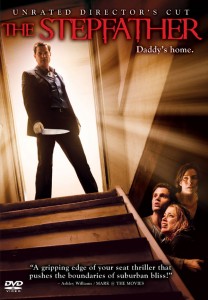BRYAN BABBLES B.S.
by Bryan Nimmo
Hello again, and welcome back to the second installment of Bryan Babbles B.S.. (That’s just a working title.) In my lifelong obsession with talking about movies, I’ve found that one of the great pleasures in life is complaining about the bad ones. Considering the appalling number of shitty horror movies I masochistically subject myself to, I end up pleasing myself far too often. Uh, okay, that sounded less wanky in my head. But anyway, onto this week’s crop of losers, two fairly recent “thrillers” which are both pretty fucking terrible.
THE STEPFATHER (2010, directed by Nelson McCormick): 4/10
Aw, this was a disappointment. Not that I expected the movie to be GOOD, mind you. Oh dear lord, no. But because I was actually hoping it would be much worse. You see, this film’s director Nelson McCormick and writer J.S. Cardone were the soulless cocksuckers who made the unbelievably awful Prom Night remake. That movie was so appalling, so wretched, so goddamned dumb that it instantly inspires wishes to invoke Godwin’s Law comparisons in most viewers. (For the uninitiated, that means somehow comparing it to Hitler or Nazis or the Holocaust; while certainly nobody should seriously make such a comparison to just a lousy movie, that one was SO lousy that you felt the urge to do exactly that.) However, The Stepfather is nowhere near that abysmally awful. It’s just mediocre and tedious, which is pretty much the worst combination ever when it comes to a film which provides almost zero entertainment on any level.
The story involves a young man named Michael (Penn Badgley) who comes home from military school to discover that his divorced mother (Sela Ward) is engaged to a new fiancé, a smiling fellow named David (Dylan Walsh). He seems a little off, like a Ned Flanders with a carefully-hidden dark side, and Michael doesn’t quite trust him. However, the game has already been given away to the audience: we know that David has previously been involved with at least two other families, and murdered all of them before vanishing and assuming a new identity. So while David occasionally kills some suspicious snoopers, Michael slooooooooowly puts the pieces together that his new stepfather just might be a stabby lunatic. REALLY slowly. The entire movie is basically characters telling each other “hey, something doesn’t feel right about this guy” over and over again for ninety minutes, followed by a short (anti)climax and then credits. We’re well past the hour mark before anyone figures anything out at all, and the whole film could have easily been cut down by twenty minutes and lost nothing important.
But that’s hardly all of the plot; no, this movie stuffs in so much filler and so unnecessary characters that it feels bloated to the point of distension. By my count, there are at least two completely gratuitous murders which have absolutely no connection to the main plot. The filmmakers must’ve noticed how damn little “horror” there was in there horror movie, and desperately padded the body count at the last second. There’s plenty of other stuff which could have easily been tossed out, or was included for dubious reasons: Amber Heard has a thankless role as Michael’s girlfriend, and appears to be in this movie for no other reason than to occasionally prance around in a bikini. There are also two younger kids in the family, and they’re in the movie so little (especially the girl, who barely gets any lines at all) that they often disappear for massive stretches of time. All these characters make sure that no tension ever builds up; a movie like this needs a lean cast, with the small number of main characters making the heroes feel isolated and in legitimate danger, with nobody to help them.
And oh yeah: it’s a fucking remake! The original 1987 version of The Stepfather was an infinitely superior film, and Terry Quinn’s version of the psycho stepdad was far more fascinating than Walsh’s bland do-over. In the remake, the killer mostly just kills people who might discover that he’s killed people before; there’s little psychological motivation for the crimes. In the original the stepdad inevitably went crazy and slaughtered his family because they disappointed him and couldn’t fulfill his impossible ideal of a perfect household. It played with the family values of the 1980s Baby Boomers, and that era’s yearning to go back to 1950s-style traditional households. The old one had a philosophical point to make; the new one is just “hey, there’s a killer doing killing, and oh look Amber Heard in a wet swimsuit”.
Two more flaws bugged me a lot. The first is that the story is basically impossible in current-day America. Back in the 80s, this kind of thing could happen; but now, in the days of DNA tests and Homeland Security and identity theft countermeasures and Google searches, there’s basically no way for someone to commit such sensational crimes and keep getting away with it and disappearing. The final big mistake was an inexplicable change in the remake: the original Stepfather’s protagonist was a teenage girl, a tiny little thing who could be legitimately menaced by that movie’s villain. In this version, we’ve got Michael, a buff male athlete who looks like he could be 30 years old, and it seems like he should be able to beat the nerdy stepfather to death with his bare fucking hands.
The weird thing is, there was one more change from the original which actually added a lot to the new movie. This time around, they added a subplot involving the ex-husband who left the family in the first place. As played by Jon Tenney, this guy feels like a real human being; he’s flawed and three-dimensional and just completely believable as a genuine person. Including this character deepens and widens the scope of the movie’s story, giving a surprising feel of history to this fictional family. So it’s a shame that the movie mostly ignores this one glimmer of psychological insight for the vast majority of its endless running time.
WHITEOUT (2009, directed by Dominic Sena ): 3/10
First, a wee bit of boring personal backstory about myself. For reasons I cannot fathom, I’ve always been fascinated by the continent of Antarctica. The very idea of the place seems so otherworldly and exotic; its vast trackless wastelands, stretching out for barren mile after mile, a gigantic piece of treacherous land which humans have barely made even the tiniest dent into. It’s almost like an alien planet, right here on Earth. In fact, I was so fascinated with the idea, at fifteen years of age I wrote a novella about a bunch of scientists in Antarctica being attacked by monsters. Some kind of caveman-like creatures who lived in a volcano and could set themselves on fire without getting hurt. I think they all died when the scientists blew up their cave with a homemade atomic bomb, iirc. Yeah, it was pretty fucking terrible. My point in this longwinded tangent? Even that shameful old story was actually better than Whiteout.
Our tale focuses on US Marshal Carrie Stetko (Kate Beckinsale). the only American law officer on the entire continent of Antarctica. Well, first things first, it focuses on her not-quite-naked body in a shower scene. You know those cloudy, translucent shower doors they use to show almost-nudity in PG-13 rated movies? Right away, they pretty much tell you that this is gonna be shit, because no good movie ever has one of those not-quite-nipples scenes. Anyway, she’s assigned by her mentor Dr. Fury (Tom Skerritt) to go check out a dead body in the middle of nowhere. Soon, she’s being stalked by a killer, and forced to team up with a smarmy Interpol agent (Gabriel Macht).
This is gonna be one of those reviews where it’s difficult to describe exactly how the movie is so bad. In theory, all of this stuff could’ve been done well. But the execution here (from director Dominic Sena, maker of such other stupid joyless crap like Swordfish and Season of the Witch) is nearly incompetent at times. For example, there’s multiple chase scenes set outside in swirling blizzards, where ferocious winds and blinding snow make it so that everyone has to clamp themselves onto a safety line. Okay, I can think of some neat cat-and-mouse stuff that you could do with that situation. Whiteout does nothing of the sort. The actors never act like they’re being yanked around by the howling gale, and the action is shot so clearly that you can easily see everything that’s going on. Hey, don’t you think we might actually wanna have a real whiteout (a polar condition where snow reduces visibility to less than twelve inches) in this movie called Whiteout? And oh yeah, there’s plenty of CGI scenery and it mostly looks really cheap and phony.
The script also makes no damn sense. It’s obvious right from the beginning who the bad guy is, in one of those “this relatively big star has been cast in a suspiciously small part… oh, he’s the villain, fuck you movie” sort of deals. But by the end of the film, his evil master plan is still absolutely incoherent. The backstory is ludicrously underexplained as well; by the end, if you can explain to me exactly what those Russian mutineers were going to do with their stolen cargo in the middle of goddamned Antarctica (or even why it was being shipped there in the first place), then you are a better man than I. The actors, being stuck in the snow with this lousy material, basically decide to phone it in. Not that I expected great things out of the likes of Beckinsale or Macht anyway, but they were barely even trying and I couldn’t blame them.
Two last things that pretty much say it all about this movie. After seeing the completed film, Warner Brothers said “oh hell no” and let it roton the shelf for two years before finally, reluctantly releasing it. It turns out they were right: Whiteout bombed horribly, bringing in a pathetic twelve million dollars in combined worldwide ticket sales which didn’t even cover a third of its budget. But perhaps more noteworthy is that this film was adapted from a graphic novel. The comic by Greg Rucka and Steve Lieber wasn’t exactly an Eisner-level work, but it was significantly more gritty and less compromising than the film. The following comparison says it all: in both the comic and the movie, the main hero has two of her fingers amputated due to frostbite. In the comic, it was her index and middle finger on her right hand, and her handicap is something she’s forced to seriously deal with for the rest of the story. In the movie, it’s the ring and pinky fingers on her left hand, and Beckinsale basically just puts on a glove and then completely forgets to ever sell the injury. Thus making this one of those “why bother adapting this material at all, if you’re gonna change everything that’s unique about it?” pieces of shit which is an insult to all fans of the original material as well as the moviegoing audience in general.
Bryan Nimmo can be found in his underground bunker, obsessively writing endless movie reviews on an ancient iMac powered by a bicycle-pedal generator. Due to the high radioactivity of the surrounding area, contacting him in person is strongly discouraged.


